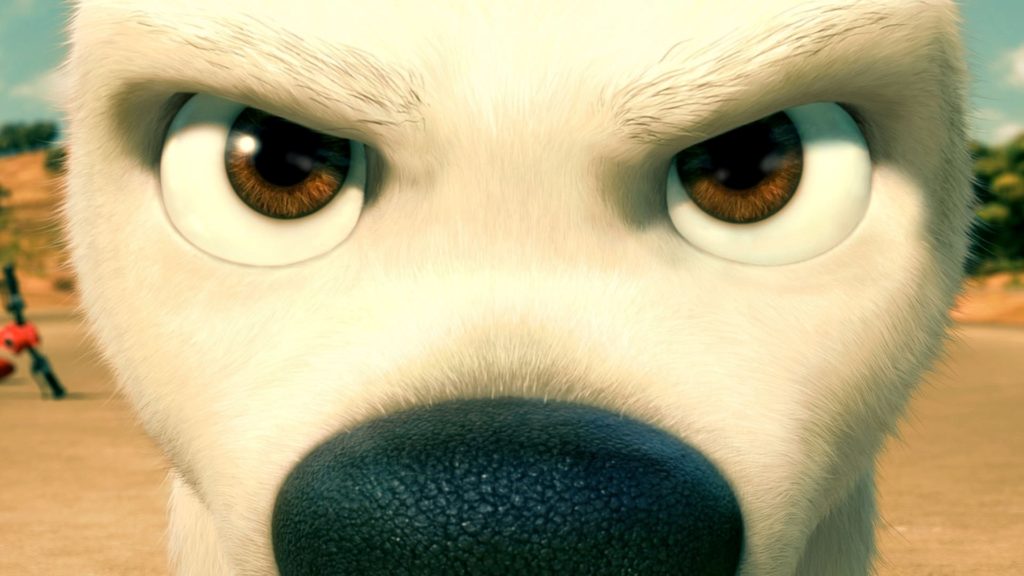The story goes like this: there’s this dog named Bolt (voiced by John Travolta) who is the eponymous star of a TV action show, in which he plays a super-powered pet who keeps saving his owner Penny (Miley Cyrus) and foiling the world-domination plans of the cat-loving Dr. Calico (Malcolm McDowell). Thing is, Bolt doesn’t realise that he’s on TV, thanks to an unhinged director (James Lipton – yes, the starfucking host of Inside the Actor’s Studio) who insists on keeping the animal in the dark out of some misguided stab at canine method acting. Yes, this is essentially a doggie Truman Show.
Unfortunately, an easily-avoidable but probably inevitable accident lets Bolt off the set one day after shooting, and in his search to find Penny (who he thinks has been carted off to some secret fortress, thanks to a rare cliffhanger ending), he manages to get himself shipped off to New York City, where he abducts an alley cat named Mittens (Susie Essman) to help him find his way to Calico’s lair. She’s a great deal quicker on the uptake than he, and when she spots the address on his collar, she sends him along to Hollywood – not expecting that the dog, mistrusting her (in his world, literally all cats are the agents of evil), will drag her along. Their cross-country trek will eventually include a TV-addicted hamster named Rhino (Mark Walton), and several minor misadventures that slowly reveal to Bolt that he’s not actually a super-dog, and Penny’s not actually in danger, but that he wants more than anything to be with her and be the best pet ever, anyway.
The story is maybe not the strongest in the world: for one thing, the first act requires Herculean suspension of disbelief, even in the context of being a talking animals cartoon (among other missteps, for the show “Bolt” to be produced in the manner we’re shown would mean that every 45-minute episode would cost about $100 million – no wonder the network is prepared to cancel it if it loses even half a point in ratings). But it’s never really about the story per se but what that story lets the filmmakers do, and directors Byron Howard and Chris Williams (who co-wrote the screenplay with Dan Fogelman) have crafted an unexpectedly charming kids’ film that, unlike just about everything else out there, doesn’t see any particular reason to treat children like soulless pop-culture receptacles – it’s a sweet and simple movie that, except for its focus on the moviemaking industry, doesn’t aim higher than an eight- or nine-year-old (even Pixar has forgotten that trick, mostly: three of their last four movies have seemed unabashedly meant for adult viewers).
Maybe I’m just a hopeless nostalgist, but I found it all very pleasant and soothing, and something of a return to core values for the studio, founded on Walt Disney’s belief not that entertainment should have something for kids and something for adults, but that sometimes, adults wanted to think like kids for a little bit – a philosophy underpinning everything from Mickey Mouse’s first reedy whistling to the great big playground in Anaheim called Disneyland. This isn’t the same as dumbing-down, like so many family filmmakers would have it; Walt’s genius lay in recognising that childishness has an integrity of its own, based in wonder, delight, and a gorgeous lack of cynicism.
It helps that Bolt is a pretty well-made film, too. The animation, though filled with soft cartoon edges and big-eyed characters, is top-notch (it’s the first film from Disney Animation since Lasseter took over the reigns, and one can’t help but ponder if there was a little bit of Pixar dust involved), and the voice performances are mostly fine. Surprisingly, the best of these is Travolta, giving his best performance in what feels like a lifetime as the tremendously earnest Bolt: no matter that he’s speaking English, there’s a definite doggieness to his enthusiasm. Actually, that’s another one of the film’s great achievements – the animals all feel like animals, and not human beings with fur. They move and act more or less like your house pets, and I can’t recall another one of the “sassy talking animals” films where that’s more than incidentally true.
Now, the flip-side to all of this is that Bolt isn’t very weighty, nor does it have the timeless quality of Disney’s finest work. It’s a mere entertainment that actually entertains, but it doesn’t see fit to stick around in your brain too terribly long after the lights come up in the theater. That alone is still enough to make it worth recommending in the awful glut of crappy animated movies that we’re currently enjoying, but it’s best not to expect it to be more than it is.
A final word, on that whole “3-D” thing. Yes, this is another film presented in Disney Digital 3-D, but it’s honestly kind of awesome anyway. For the first time in the current 3-D wave, I didn’t see more than a couple of obvious “throw something at the camera” gags, and more importantly, this was the first film that seemed to go deep rather than come up from the screen. In other words, the closest elements are level with the front of the screen, so to speak, and the dimensionality is all “into” the picture. So it’s more like a shadow-box, and not a pop-up book. It’s all done with subtlety and grace enough that after a while I forgot that it was 3-D at all, which I doubt was the goal, and it absolutely failed to add anything. But it wasn’t annoying, and for that I must instantly award it the title of the best 3-D film of the ’00s.
7/10
